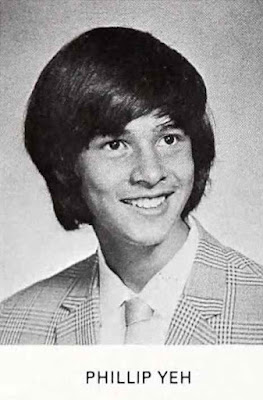May is Asian Pacific American Heritage Month
Phillip Dana “Phil” Yeh was born on October 7, 1954, in Chicago, Illinois. His parents were Te Fung Yeh (1923–2015) of Shanghai, China, and Ruth Opal Williams (1924– ) of Illinois.
In the 1950 United States, Census Te Fung (line 1) resided in Chicago at 337 East 50th Street. I believe he was a student at the Illinois Institute of Technology.
Yeh’s parents married on August 22, 1953. Yeh was the oldest of four siblings who were David (1957–2016), Bettie (1958) and Kathleen (1959).
On October 27, 1955, Te Fung, a designer and mechanical engineer, filed a naturalization petition. He immigrated in 1948. He was naturalized on January 17, 1956. His address was 6102 South Woodlawn Avenue in Chicago. At some point Te Fung moved his family to southern California.
Yeh was a student at Los Alamitos High School in Los Alamitos, California.
He graduated in 1972.
He continued his studies at California State University at Long Beach.
In 1985, Yeh was the ringleader of Cartoonists Across America & the World.
Read about Yeh at his website.
Further Reading and Viewing
Shel Dorf Tribute, Phil Yeh, Godfather of the Graphic Novel, About the Positive Difference Shel Has Made
Santa Ana Register (California), March 28, 1976, Young Artist Makes Strides in Early 20s
The Buyer’s Guide #211, December 2, 1977, Cobblestone advertisement
Cascade Comix Monthly #11-12, February 1979
Cascade Comix Monthly #13, March 1979
Cascade Comix Monthly #14, April 1979
Cascade Comix Monthly #15, May 1979
Cascade Comix Monthly #16, June 1979
Cascade Comix Monthly #18, February 1980
Cascade Comix Monthly #21, May 1980
Cascade Comix Monthly #22, February 1981
The Comics Journal #87, December 1983, Phil Yeh: Artist, Publisher, Dreamer
Press-Courier (Oxnard, California), March 8, 1986, Cartoonists Plan to Fight Illiteracy
National City Star-News (California), September 13, 1987, photograph
Press-Republican (Plattsburgh, New York), May 10, 1988, Cartoonists cross America for literacy
Gadsden Times (Alabama), May 19, 1988, Expo ’88 planned Friday
The Times-News (Hendersonville, North Carolina), February 1, 1991, Stamps, New releases from Hungary
Press-Courier (Oxnard, California), February 10, 1991, Stamps in the News
Press-Courier (Oxnard, California), April 21, 1991, Cartoonists plan mural of dinosaurs
Press-Courier (Oxnard, California), April 24, 1991, ‘Recycle, Avoid Extinction’
Bangor Daily News (Maine), December 7, 1992, ‘Turtles’ Creator establishes museum of comics illustration
Williamson Daily News (West Virginia), December 7, 1992, New museum marks acceptance of comic books, funnies as art
The Telegraph (New Hampshire), December 8, 1992, In this museum, comic books and funnies are high art
The Free Lance-Star (Fredericksburg, Virginia), December 9, 1992, Ninja Turtle co-creator opens comics museum
Daily News (Bowling Green, Kentucky), December 13, 1992, Museum dedicated to comics as an art form
Moscow-Pullman Daily News (Idaho), December 17, 1992, New museum marks acceptance of comic books, funnies as art
Albany Sunday Herald (Georgia), December 20, 1992, Comic books become art
Reading Eagle (Pennsylvania) November 18, 1993, Literacy gets a free ride
Victoria Advocate (Texas), March 3, 1997, Artist uses comic book characters to promote literacy
New Straits Times (Malaysia), June 16, 1997, World Book Fair ’97 advertisement
Victoria Advocate (Texas), October 17, 1997, Promoting literacy
Victoria Advocate (Texas), April 12, 1998, Grocers and banks teaming up
Victoria Advocate (Texas), April 15, 1998, Bank to open 85th
Bellmore Life (New York), August 15, 2001, Paint a cartoon mural
Sag Harbor Express (New York), September 8, 2005, Be There 12/20
American Profile, May 7–13, 2006, Cartoonist Combats Illiteracy
Sarasota Herald-Tribune (Florida), June 15, 2006 Family fest celebrates world cultures and literacy
The Vindicator (Youngstown, Ohio), June 18, 2006, Cartoonist to play with dinosaurs
The Sun & Record (Williamson, New York), October 26, 2006, Yeh coming to Williamson Library
The Lake & Valley Clarion (Geneseo, New York), November 2, 2006, Comic Book Author/Illustration Program
Theo the Dinosaur (International Humor Advisory Council, 1991)
Secret Teachings of a Comic Book Master: The Art of Alfredo Alcala (International Humor Advisory Council, 1994)
The Great Women Superheroes (Kitchen Sink Press, 1996)
Men of Tomorrow: Geeks, Gangsters, and the Birth of the Comic Book (Basic Books, 2004)
Dinosaurs Across America (NBM, 2007)
Secret Teachings of a Comic Book Master: The Art of Alfredo Alcala (Dover Publications, 2015)
Places, Eastwind Studios, 2022
(Next post on Monday: Fred Proctor, Newspaper Artist, Letterer and Scenic Designer)
































